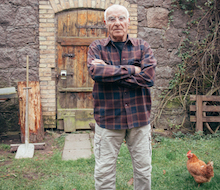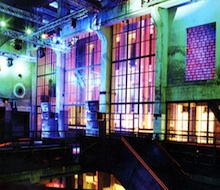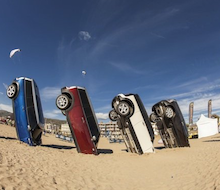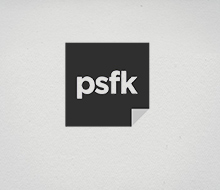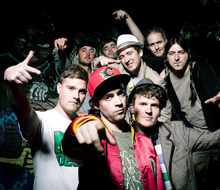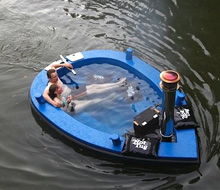Just because we don VR headsets instead of war paint these days doesn’t mean we’re not still hunters and gatherers still by nature. The only difference between us and our primal ancestors? We now hunt in jungles made of concrete, with iPhones as weapons, and cool cred, rather than survival, at stake.
Now, If anyone is an expert of cool hunting in the age of the smartphone, it’s General Manager of Nike’s NYC Digital Studio and SNKRS app Ron Faris. The former CEO of Virgin Mega has spent over a decade conceptualizing how to share experiences and grow communities ephemerally on mobile phones. He was the brains behind Virgin’s “MegaLine” app that revolutionized the concept of a waiting line by letting fans compete with each other for limited edition products on their phones as they waited. Now he heads up Nike’s first digital product, design and tech studio in downtown NYC that creates experiences for Nike’s passionate Sneakerhead community. Until recently, the hunt for exclusive kicks was often hijacked by scammers who would use bots to crawl webpages or pay other people to wait in line. To combat this, Ron’s team developed the Nike SNKRS app complete with a SNKRS Cam that prompts users to find images or photos in the wild, and then utilizes augmented reality to unlock a purchasing window. Its other functionality, SNKRS Stashes, is location-based, prompting users to convene at a physical spot to be able to purchase a shoe while Shock Drops alert users to immediate drops at local boutiques via push notifications where they purchase the shoe from a storefront.
I spoke with Ron about creating ephemeral communities in a world where Nikes aren’t just shoes anymore, they’re status symbols—like a Rolex, for your feet.
Emily Wasik: Can you shed light on the current state of experiential marketing?
Ron Faris: Right now, we’re seeing that the consumer, especially the younger consumer—the mobile millennial—is very picky about the brands they’d like to pay patronage to. Their relationship with a brand is far more emotional than it was in the past. It’s no longer the brand dictating the terms of the relationship, but the community. In Nike’s world, this is the sneaker community. We’re finding more success in not speaking to the community, but enabling the community to collaborate and communicate to one another with digital tools. In our example, it’s been through the access to purchase our premium, limited edition sneakers. When we look at what consumers look for and the behavior they have, every feature that’s digital or digital-to-physical really has to strike an emotional chord. Building features that can build energy and emotion in our consumers is most successful in driving consumer loyalty.
Why was the Virgin Mega and Nike collaboration such a great fit and what is your advice for brands looking to successfully sync up with other brands?
Nike’s natural DNA is to really understand the emotional state of their consumers, their attributes, and what are the things that drive them to purchase and love the Nike brand. There are so many brands out there that really don’t put themselves in the shoes of the consumer. They might know the demographics, but understanding the psychographics of the consumer is paramount to building a long-lasting brand. Nike’s priority of selling shoes is never at the sacrifice of building a relationship with the consumer. Their relationship is always organic, honest and authentic. That is something that really resonated with us when we were at Virgin Mega because through my 10 years at Virgin, I learned that it’s crucial to build an authentic relationship with the consumer. Where we felt we could help was in how to translate that behavior and those types of relationships into the digital ecosystem—into a mobile-first ecosystem.
It’s about building the types of experiences that are more immersive that would make you feel the same way as if you attending Burning Man or a music festival—sparking a type of energy that goes far beyond e-commerce and a store. If you can build those types of experiences that lead to a purchase and do it authentically and organically, the consumer will pay attention for longer and they’ll have a harder time leaving you or turning away. When we started to realize that we could really help one another, that’s what led to the eventual acquisition a year ago.
Your plan in your previous role with Virgin Mega was to build a team of engineers and product staff who would use data to test new types of mobile experiences. Can you shed light on some recent trends in mobile experiences today?
What’s really important right now is the quality of usage, the quality of connection. In the first phase of social community everybody was following everybody. It was all about increasing your follower count. It was about the novelty of the follow. Then in phase two, it was about really valuing and putting a premium on the intimate connections—one-to-one, peer-to-peer messaging, like with Snapchat. Where I think we’re getting to in the third phase is that people now come together ephemerally and connect over a common bond they have over a topic. It’s no different than when someone plays basketball on Tuesdays and make friends with people they see on Tuesdays, and that’s their association forever.
This idea of an ephemeral community of people coming together around a specific passion point is where we start to see very heated, high energy levels of interaction that borderline on a form of addiction. That’s the part that we find super fascinating—the relationships people have in these bursts of moments, typically when a shoe is announced or dropped. Those are the types of moments where we want to be present, not just on our app but at all the social water coolers that we call Instagram, Facebook, Snapchat and so on.
You’ve said in the past that, “Done well, we believe that tribe marketing empowers a brand to behave like an effortless host at a cocktail party. She finds attributes of her guests and uses them to allow the guests to interact with one another, but then she steps away.” What are some really standout examples of ephemeral communities that have been developed in the experiential space?
There is a shoe that launched in the ’90s called the Foamposite One. It was worn by Penny Hardaway from Orlando Magic. The folklore of the story is that the NBA didn’t want him to wear the shoe because it didn’t have enough black in it to match his uniform which was against NBA regulations.Penny Hardaway loved this shoe so much that he grabbed a Sharpie pen and colored in 50 percent of the shoe in black so that he could wear it on the court, which is just a hilarious, wonderful bit of mythology in sneaker culture. When we were re-releasing the shoe, we wanted to honor that story with an immersive experience that would showcase that moment.
What we did was we embed Easter eggs in the app so that as you were swiping through products in the app, you’d realize that you couldn’t swipe past the image of the shoe. Instead when your finger tried to swipe, your finger would actually start to draw on the screen. In other words, your finger itself was the Sharpie. If you colored in the shoe in the same pattern Penny Hardaway did, it would unlock a secret video from Penny Hardaway where he would say, “Congratulations, you’ve unlocked one of the first pairs available for purchase.”
We estimated maybe we’d get 10,000 unlocked, and we ended up getting something like 80,000 unlocks in just three days. All we did was create the tool, gave it to the community and then stepped away so the community told one another the story. We knew there were enough people in the community that knew the story from back in the day, and we wanted them to educate those who knew less by showing them how to unlock it. As they were giving each other instructions on how to unlock the pair of shoes, they were also telling the story around the campfire, which, in our mind, furthers sneaker culture. It’s a great example of how Nike can do less talking by creating an experience that lets the community do more of the talking.
I’ve spent many years building fanatical communities. Prior to Nike, I was building music communities at Virgin. Before that I was building video game communities. The ingredients of a fanatical community are the same across sneakers, video games or music in that there are about 15 percent of the community that are hardcore and 85 percent that are casual.
The hardcore gamers, music fans or sneakerheads have all the time in the world to absorb all the knowledge and box out anyone who isn’t at their level of participation. The casual people are intimidated to engage in the conversation because they know that they don’t know as much. For us, the perfect fanatical community that drives commerce is one that’s harmonized between those that are hardcore and those that are casual. The hardcore community members educate the casual ones with content tools to show off their knowledge.
We build our immersive experiences to be emotional and around energy, in a way that alienates no one. We do them in a way that will embolden and empower those that know more, in a way where they’re incented accordingly, through different currencies, to teach that their knowledge others.
One currency is influence—because those bestow that knowledge become more influential in the community. That may result in more personalized products for them, earlier access and different rewards.
In these scavenger hunts you tease the release of these shoes and you alert the patrons that they will only be available through the Nike SNKRS app, in a specific location, at a specific time of day. Can you expand on how Nike aims to make these hardcore fans feel like they are being given an exclusive experience?
I think the idea where there are a limited number of shoes available and you have the opportunity to have one, and that it’s democratized only to those that are the collectors or the true fans as opposed to resellers (because we’re offering it to those who value the relationship more) rings true to the traits of exclusivity.
We just happen to use scarcity and urgency as the ingredients to maintain that exclusivity. What’s awesome about our world now is that with such robust targeting tools and really sophisticated digital tracking, we’re able to target very hyperlocally down to like a playground basketball court where we can turn any center into a retail outlet for exclusive product.
When you start to look at the market hyperlocally, you can start to unlock more exclusive moments for different tribes of people. That introduces is a concept of exclusivity at scale, which sounds paradoxical, but when you’re really having different conversations with different tribes, they don’t really collide with one another.
We can offer one moment of exclusivity to a basketball court in the Lower East Side of Manhattan while we create another moment of exclusivity in a Chinatown in Chicago that’s celebrating a Michael Jordan Chinese New Year shoe that we’re dropping. I may be speaking to two different audiences hyperlocally because my product may embody some of the traits of that neighborhood and feel exclusive to the people who are participating. I think that’s really where the opportunity is unlocked, to think hyperlocally through digital.
This is especially pertinent in a market that has long been restricted to modern day shoe-tropolises like New York and Los Angeles. I know that the SNKRS app, it evens things out in sense because it gives those outside of these major cities their own chance to get their hands on kicks. How is Nike designating specific areas, locals, and backdrops for fans to use apps or services to create shared experiences and also encourage fans to share their passions with one another?
Emily: Digital has brought was the pervasiveness of scale so that you can now reach all of those people in non-sneakerhead cities.You can get your product in the hands of millions of people instantly with one-touch purchasing and create an incredibly seamless experience. However, we realized that we lost a bit of the cultural cache and the soul of what it means to participate in sneaker culture because everything became reduced to an online store.
Although our first iteration of the SNKRS app was wildly successful in terms of commerce, it was missing that feeling of community and soul within it. So features like Shock Drop, the SNKRS Camera, and Stash were created to reinvigorate that sense of community and that thrill of the chase that all sneakerheads enjoy. What we found is the reason those immersive experiences matter is because the world of commerce is moving to the world of digital. We see the moves that Amazon has done to make strides across a host of different sectors to capitalize on it. The brands that will matter are those that can cut through the clutter and create brand experiences that lead to purchase in a way that brings emotion and energy to shopping.
The last thing I want SNKRS to be is a store. What I want the SNKRS app to be is a club and a place where people can come and share their stories about hunting and chasing sneakers. That starts with providing a level of exclusive access based on a currency of attention, where people want to engage with us in more robust and unique ways.
Using augmented reality through the SNKRS Camera is a great way, for example, to unlock a beautiful rendering of a shoe off any piece of art that you can find in a physical or digital ecosystem. Those types of experiences really start to trend with our community and reinforce Nike’s commitment to sneaker culture.
What are some of the biggest challenges and opportunities you are seeing in this market when it comes to creating this new immersive content that is less about storytelling and more about story living?
The top challenge is the learning curve. When you invent a new type of experience, often the community is used to a certain way of behaving and interacting with a brand. You have to spend a lot of time user testing and making sure you don’t lose your audience to deliver an immersive experience. Stash, for example, is an entirely new way to congregate to buy shoes in a physical space. I know a little something about lines, having built the business Virgin Mega about disrupting the idea of what it means to be in line. Typical lines are linear, and they are selfish in nature. When you’re not in a line, you’re wondering what the line is for, and when you’re in a line you just want it to get shorter.
When we did Stash we started to unlock the behavior of people getting down to the end destination. Not fulfilling on site but fulfilling digitally so that it was shipped to your home but you still had to go to a physical location to redeem. The line of the future to us is not a linear line of people being tired and sleeping out all night, waiting for their coveted kicks.
The line of the future is pods of three or four people huddled around cell phones helping one another check out and get the shoe. You would never have seen sneakerheads help one another get a shoe in the past, because they’d be threatened with potential violence or someone taking the shoe away from them. In this new digital world, you have a far more friendly and social atmosphere where people are helping each other get the shoe. We actually took raw footage of one of our Stashes, and it’s really exciting to see how the behavior has changed.
How has the growing role of influences, particularly micro influences, influenced brand promotion and content marketing, especially in the realm of Nike?
Now more than ever the micro influencer is king in the sense that brands are more interested in the influence of someone who hovers at around 20 to 30 thousand followers than someone who is at 200,000 followers only because I think their authentic connection with their fans is more real.
I think that they are hungrier and wanting to get to the next level and will do more. When collaborating with these folks, there’s less of a team that you have to work through.
We do live in a world today where influencers on Instagram are the new mannequin. They showcase the wares of all these brands, and fans really take to that. Often times across many brands it’s at the sacrifice of great design.
Unfortunately some products that sell really well that aren’t designed with the level of premium, but the right person was wearing it so then it becomes trendy and fashionable. This is really what happens with what’s in style at the moment. Influencers are at a peak of really moving the needle of what people will buy, but it’s a pendulum and it will swing the other way where thoughtfulness of design will start to come back into the picture.
What I think gives Nike the longevity in the market is that it will always have premium design in its crosshairs because i always focuses on premium design through the lens of sport. I think that is something it’s stood for over the past 40 years, and it will stand that way for the next 200. Although the influencers wield power for these smaller brands today, I find it to be very fickle. What will trend today with the right influencers may go out of style very quickly. As fast as the rise, so goes the fall. That’s the cost of working with influencers.
Can you possibly shed light on the next generation of brand experiences? How do you think experiential marketing will evolve in the next 5 or 10 years?
Because of the pervasiveness of digital tech and the super hyperlocal nature of it, you’ll start to see experiences really look through the lens of commerce. I see that a brand’s primary job will be to create an immersive experience that will drive you to the compelling-ness of the product to purchase. In the future, as more people adopt these tools, the community will play a greater part in driving consumers to what products to purchase based on the compelling-ness of the experience. I don’t think the experience will be solitary.
The experiences will be more communal. We will always strive to create the same level of energy through a mobile phone that is felt when you are at a physical music festival. Because that way you can feel part of a community, part of something bigger, but through what will be the solitary access of your phone.
Augmented reality will stop becoming a toy aor sheer entertainment in the form of video gaming. It will start to serve utility in the form of simulating experiences that will provide access to those in markets that are neglected.
If people start to master immersive experiences digitally, people will think less about the top 5 or top 10 markets of where to spend and advertise, and really start to think about hyperlocal communities and tribes where they can invest to reach their consumer directly.







